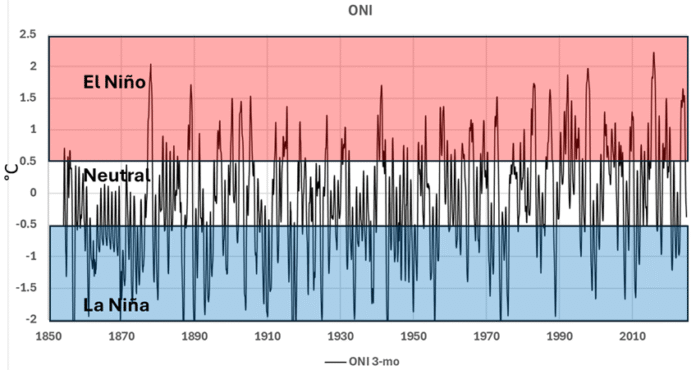By Andy May
The Oceanic Niño Index or ONI is NOAA’s primarily indicator for monitoring the sea surface temperature (SST) anomaly in the critical Niño 3.4 region. It is a 3-month running mean of ERSST.v5 SST anomalies in the Niño 3.4 region, defined as 5°N-5°S and 120°W-170°W. Figure 1 shows the ONI as computed from the NOAA ERSST dataset. ERSST is a two-degree gridded dataset, so the region averaged for figure 1 is 6°N-6°S and 120°W-170°W.

Per convention a three-month moving average has been applied to the raw ONI data in figure 1. Sometimes you will see the ONI detrended, but the curve in figure 1 is not detrended and has an upward slope of one-half degree per century. The 3-month moving average has to exceed 0.5°C for five consecutive months to define an El Niño, so the chart is colored red above 0.5°C. The same is true for La Niña, but in reverse. The white area between -0.5 and +0.5 is ENSO neutral.
The current ENSO state, as of July 2025, is ENSO neutral, with an average ONI of about zero. NOAA prefers to use a base period for their ONI anomalies of 1991-2020, but we use 1961-1990 to be consistent with the other posts in this series and with HadCRUT5. There is a visual trend over the past 175 years, Niños are more common now and stronger than in previous years. Climate models have a very hard time duplicating ENSO over both short and long periods of time (IPCC, 2021, p. 115). The Niño 3.4 region is shown in figure 2 in red.

Strong Niños expel a lot of ocean heat into the atmosphere, and this warms Earth’s surface for a few years, but in the longer term, Niños signal future cooling, just as in the longer term, frequent Niñas signal warming or a stable global temperature. However, this is qualitative, the correlation between ENSO or ONI and HadCRUT5 is poor, as shown in figure 3.

As figure 3 shows, the correlation between ONI and HadCRUT5 is especially poor since 1990. Since then, they trend in different directions, the ONI trends down at 0.4°C per century and HadCRUT5 trends upward at 2.3°C per century.
On climate.gov, NOAA’s Michelle L’Heureux writes:
“ENSO is one of the most important climate phenomena on Earth due to its ability to change the global atmospheric circulation, which in turn, influences temperature and precipitation across the globe.”
Indeed, this is what nearly everyone believes. The current phase of ENSO does have a planetwide influence on weather, thus it is odd that the current measure of climate change, global mean surface temperature or GMST from HadCRUT5, does not trend with ENSO or even in the same direction over the past 35 years. This 35-year climatic period is when we have the best SST data.
History
The term El Niño has evolved in its meaning considerably over the years (Trenberth, 1997). It originally named a weak warm coastal current that runs southward along the coast of Ecuador around Christmas. However, it is now used to describe extreme warming events along the tropical western South American coast every ~2.5 to ~6 years (Rasmusson & Carpenter, 1982) and (Ghil, et al., 2002) that are associated with changes in Pacific equatorial currents and atmospheric circulation. Rasmussen & Carpenter give a detailed chronology of the study of the El Niño phenomenon in their 1982 paper, and they discuss the early work on this complex and important oscillation from before 1920, even then it was recognized as an oscillation with a global reach.
The first effort to standardize the definitions of El Niño and La Niña episodes was by Kevin Trenberth (Trenberth, 1997). He defined an El Niño event as when a 5-month running mean of sea surface temperature (SST) anomalies in the Niño 3.4 region (5°N-5°S, 120°-170°W) exceeded 0.4°C for 6 months or more. Since his original paper was published this definition has been modified as given above, such that the six months was reduced to five, the 0.4°C raised to 0.5°C, and the 3-month running mean rather than Trenberth’s 5-month running mean was used. The same definition applies to Niñas, but for a decrease in Niño 3.4 SST of 0.5°C.
Regardless of the definition used, the ENSO phase changes involve huge changes in the ocean and air circulation over the entire equatorial Pacific, and they affect the entire world. I found the NOAA illustration shown in figure 4 to be very helpful.

The Niño 3.4 region is roughly located on the figure, also see figure 2. The Niño 3.4 region is warm during Niños, cool during Niñas, and in between during neutral periods.
Discussion
The global mean surface temperature, the global mean ocean surface temperature and the AMO, in the 20th century, follow a 64-year period (Wyatt, et al., 2012a). ENSO and the ONI do not follow this pattern, the only statistically significant oscillation periods in the various measures of ENSO are from an analysis of SOI, Southern Oscillation Index, which is very similar to the ONI. The periods that are significant at the 99% level are 5.5 years and 2.4 years (Ghil, et al., 2002). Ghil’s analysis is illustrated in figure 5.

ENSO has a worldwide impact but does not appear to contain the global 64-year oscillation described by Marcia Wyatt or the ~60-year oscillation described by Nicola Scafetta and many other writers and researchers. In fact, the only oscillations in this series that contain a significant 60-70-year period component are the global mean surface temperature, the global mean sea surface temperature and the AMO (see here).
In the next post we will look at the global ocean temperature and reflect back on the oscillations discussed in this series.
Download the bibliography here.
Previous posts in this series:
Climate Oscillations 1: The Regression
Climate Oscillations 2: The Western Hemisphere Warm Pool (WHWP)
Climate Oscillations 3: Northern Hemisphere Sea Ice Area
Climate Oscillations 4: The Length of Day (LOD)
Climate Oscillations 6: Atlantic Meridional Model
Climate Oscillations 7: The Pacific mean SST
Climate Oscillations 8: The NPI and PDO
Climate Oscillations 9: Arctic & North Atlantic Oscillations
Climate Oscillations 10: Aleutian Low – Beaufort Sea Anticyclone (ALBSA)
Related
Discover more from Watts Up With That?
Subscribe to get the latest posts sent to your email.



